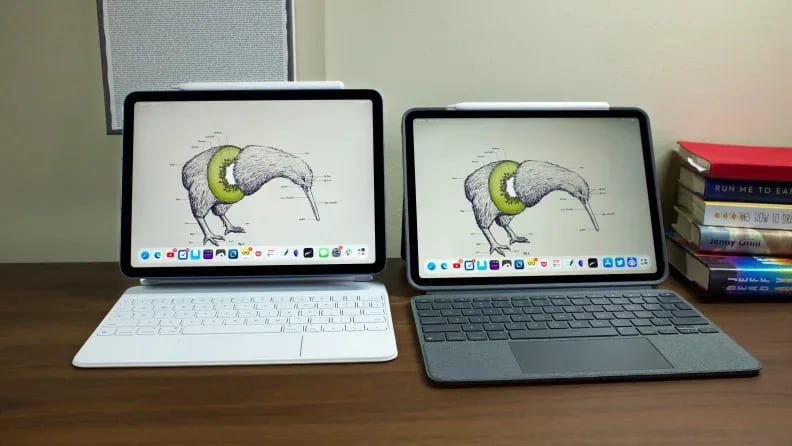iPad Air M1 vs iPad Pro M1: Which one should you buy?
They have a lot in common, but their few differences really matter.
 Credit:
Reviewed / Jordan McMahon
Credit:
Reviewed / Jordan McMahon
Products are chosen independently by our editors. Purchases made through our links may earn us a commission.
With the release of the M1 iPad Air earlier this year, Apple's narrowed the gap between the Air and the Pro. They have the same M1 chip inside, roughly the same-sized display, and they work with all the same accessories. But, after spending hours with each tablet, I noticed e a few noteworthy differences between the two tablets, like FaceID, price, upgrade options, and a higher refresh rate. Here's how the iPad Air M1 and the iPad Pro M1 11-inch stack up against each other.
Buy the iPad Air M1 from Apple now
Buy the iPad Pro M1 11-inch from Apple now
Display

The iPad Pro display's clearest advantage is its higher 120 Hz refresh rate, which makes scrolling web pages, playing fast-paced games, and watching videos all look significantly better.
Despite sharing the same 264 pixels per inch, the latest 11-inch iPad Pro features a slightly larger display than the new iPad Air, which has a 10.9-inch display. In practice, you won't notice the difference, but the bezel on the Air is slightly larger than the one on the Pro. Other than that, both tablets feel about the same size in the hand, and they're both comfortable to hold.
In addition to slightly slimmer bezels, the 11-inch Pro's display is also brighter than the Air's with a max brightness of 600 nits. The Pro also has a higher refresh rate of up to 120Hz, which makes scrolling look smoother, and can reduce lag when doing illustrations with the Apple Pencil.
Our pick: 11-inch iPad Pro
Performance

With a good accessory or two, you can take better advantage of the Air and Pro's snappy M1 chip.
Both tablets feature Apple's snappy M1 chip, giving both tablets access to a laptop-class processor for the first time. In practice, that paves the way for fast multitasking, snappy gaming, and smooth video processing.
The M1 iPad Pro gets a slight edge in the RAM department with the option to upgrade to 16GB (most models have 8GB), but that's only available for the 1TB and 2TB models, so you'll have to shell out a good chunk of money to double up.
Both tablets are still held back by the restrictions of iPadOS, such as poor window management, lack of support for a second monitor, and limited file management. While the M1 chip is a welcome upgrade to both tablets, these limitations make it hard to take full advantage of all that extra power.
Our pick: 11-inch iPad Pro
Accessories

Thanks to the laptop-class M1 chip inside both the iPad Air and iPad Pro, either one can easily switch from a leisurely tablet to a powerful workstation.
If you're planning on using your iPad to get any work done, you'll want a keyboard and maybe a stylus. Luckily, picking between the Air and Pro won't mean choosing from a different pool of accessories, since both iPads share roughly the same design and work with all the same gear.
For instance, both can snap onto Logitech's Combo Touch keyboard case when you need to type out an essay or two, and both have magnetic panels on their sides to hold the Apple Pencil when not in use.
Our pick: Tie
Price
At first glance, the iPad Air's starting price of $599 seems like a pretty distinct advantage over the 11-inch iPad Pro's $799 starting price, but it's not quite that simple.
The entry-level iPad Air only has 64GB of storage, which won't be enough if you plan on making this your workstation, want to install games, or if you like storing your photos on a local drive instead of the cloud. Your only option is to upgrade to 256GB, which adds $150 to the price.
That same $150 could also take you from the entry-level Air to the entry-level Pro, which comes with 128GB of storage. That's less than what you'd get for the same price increase on the Air, but you'll get FaceID instead of TouchID, two additional speakers, plus a higher refresh rate, and 128GB of storage should be plenty for most people.
Our pick: Tie
Security

Despite the slightly larger display on the iPad Pro, both work with the same pool of accessories.
Both iPads have security measures to keep prying eyes away from your sensitive information. The Air uses Apple's older TouchID sensor, which is housed atop the iPad's power/display button. It works well enough, but you still have to move your hand to unlock the iPad and pair each finger individually if you don't want to have to use the same one each time.
Meanwhile, the Pro uses FaceID, which is faster and more convenient than TouchID. It's almost instantaneous, you don't have to shift around too much to get your face in the frame in most cases, and you only have to set it up once.
Our pick: 11-inch iPad Pro
And the winner is...
The Air's lower price tag is certainly enticing. For $600 you can get a tablet with a laptop-class processor, access to all the same apps as the Pro, and nearly all the same features. Unfortunately, for your money, you'll get an underwhelming amount of storage, and the extra $150 you'd spend to upgrade the storage would be better spent on the upgraded features that come with the 11-inch iPad Pro.
For that extra $150, you'll get double the storage with 128GB, a four-speaker stereo array instead of the Air's 2, a higher refresh rate for games and movies, and better security measures.
In a perfect world, Apple would offer an entry-level iPad with sufficient storage for the long haul. That's not the case with the latest iPad Air, which severely diminishes its value compared to the iPad Pro. It's still a perfectly fine tablet, but for just a little more, you can get a much better one.
Buy the iPad Air M1 from Apple now
Buy the iPad Pro M1 11-inch from Apple now
The product experts at Reviewed have all your shopping needs covered. Follow Reviewed on Facebook, Twitter, Instagram, TikTok, or Flipboard for the latest deals, product reviews, and more.
Prices were accurate at the time this article was published but may change over time.


